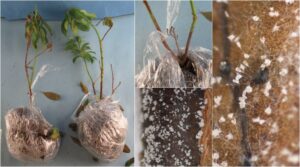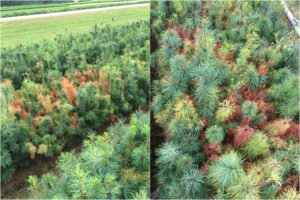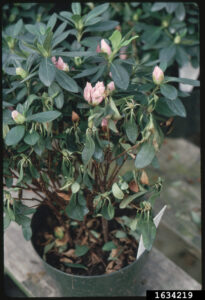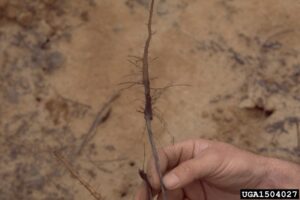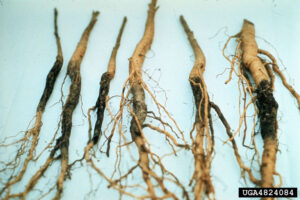Plants that show little growth, are stunted, or are wilted and in active decline are all hallmarks of root stress. Some of the more prominent pathogens that cause root rot include Fusarium, Phytophthora, Pythium, and Rhizoctonia, but there is another fungus which can cause just as much damage in the right situation that does not get as much press: Cylindrocladium. The name Cylindrocladium is used for the asexual stage of the fungus Calonectria, so if you see either name, they are used for the same organism.
There are a lot of Cylindrocladium species which have been observed to cause disease in over 300 plant species throughout the world. The diseases Cylindcrocladium can cause range from leaf spots, cankers, and stem blights to root, crown, and cutting rots (Figure 1, 2, 3). Symptoms may vary between hosts and the fungus can potentially infect every plant part of some plant species. Boxwood blight is another specific example of a disease caused by a Calonectria species. I will be sticking to the roots here, so if you would like to read more on boxwood blight, please see the links below in Additional Resources.
- Figure 1. Pieris plant with Cylindrocladium root and crown rot. Brown to black lesions can be observed at the base of the plant. After incubating the stem tissue, spores produced by the fungus can be observed growing from the stem surface. Photo Credit: PPDL
- Figure 2. Pine seedlings growing in a nursery are dying due to Cylindrocladium root rot.
- Figure 3. Nursery grown azalea with Cylindrocladium infection. Photo Credit: Penn State Department of Plant Pathology & Environmental Microbiology Archives, Penn State University, Bugwood.org
When a plant is infected by Cylindrocladium, dark gray, almost black, lesions can develop on the affected tissue (Figure 4,5). In woody plants, seedlings, saplings, and smaller trees are usually infected more frequently. Infections can begin on the tap root or at the root collar. Vertical cracks may develop along the length of the lesions, creating a rough, fissured appearance (Figure 5). The initial lesion can spread and eventually girdle individual roots or the main stem of the seedlings, which can eventually kill the tree. If the lesion is low enough on the main root, you may see new roots begin to develop above where the lesion occurs.
- Figure 4. Black walnut-Black discoloration of the root system of a black walnut seedling caused by Cylindrocladium Photo Credit: Paul A. Mistretta, USDA Forest Service, Bugwood.org
- Figure 5. Tulip poplar black lesions with vertical fissures in Tulip poplar roots caused by Cylindrocladium. Photo Credit: Edward L. Barnard, Florida Department of Agriculture and Consumer Services, Bugwood.org
Cylindrocladium produces microscopic clusters of rod-shaped conidia in crystalline bundles that are highly sticky. They disperse primarily by water splash dissemination, so rainfall or overhead irrigation can increase disease spread, however, since the spores are so sticky, they can be easily transferred by contaminated tools. Conidia can be produced throughout the growing season, so repeat infections occur very frequently. We typically see Cylindrocladium root and crown rot problems in nurseries, but infected plants can be transferred to the landscape, transporting the fungus to a new location. It can survive in plant debris or in the soil for 15 years or more because it produces survival structures called microsclerotia which can withstand extreme weather conditions and germinate when the weather becomes conducive for growth.
Management of this disease issue can be difficult for a number of factors:
- Repeat infection cycle means continuous management throughout the season
- Broad host range which can lead to potential transfer from one host in a nursery setting to another nearby, yet different plant species
- Fungicides may not provide adequate control or cannot provide curative benefits to stem and root infections.
- Microsclerotia can survive for a very long time in the site, so once it present, you will not be able to easily get rid of it.
Management Strategies:
- Start clean and stay clean: always choose healthy plants or return plants that have dead stems, are turning yellow, or in decline.
- When propagating, do not take cuttings from stressed or wilting plants
- Quarantine plants when you first receive them and monitor for disease development before moving into your normal growing area or into the location it will be installed.
- Cull diseased plants or remove and destroy infected plant parts. Use disinfectants on pruners and other cutting tools to reduce the risk of spreading the pathogen from an infected plant to healthy plants.
- Avoid overhead irrigation, where possible, to reduce the potential for pathogen dispersal
- Increase plant spacing, if possible, to help slow down disease spread; this affects humidity and airflow between plants but also increases the distance water droplets need to travel to get to another plant.
- Fungicides can be used in conjunction with cultural management strategies to reduce disease spread and slow down disease progression, but it can be very costly in a landscape and even in some nursery settings.
Additional Resources and References:
Root Rot – Purdue Landscape Report
https://purduelandscapereport.org/article/root-rot/
Cylindrocladium Root Rot – Purdue Plant Doctor
https://purdueplantdoctor.com/factsheet/tree-406
Diseases of Trees and Shrubs (Sinclair and Lyon); page 220-221.
Root rots and blights caused by Cylindrocladium and Cylindricladiella
https://www.cornellpress.cornell.edu/book/9780801443718/diseases-of-trees-and-shrubs/#bookTabs=1
Impact of Calonectria Diseases on Ornamental Horticulture: Diagnosis and Control Strategies
Aiello et al. 2022: https://apsjournals.apsnet.org/doi/epdf/10.1094/PDIS-11-21-2610-FE
Boxwood Blight:
https://purduelandscapereport.org/article/boxwood-blight-be-on-the-look-out/
https://www.extension.purdue.edu/extmedia/BP/BP-203-W.pdf
https://purdueplantdoctor.com/factsheet/tree-404
